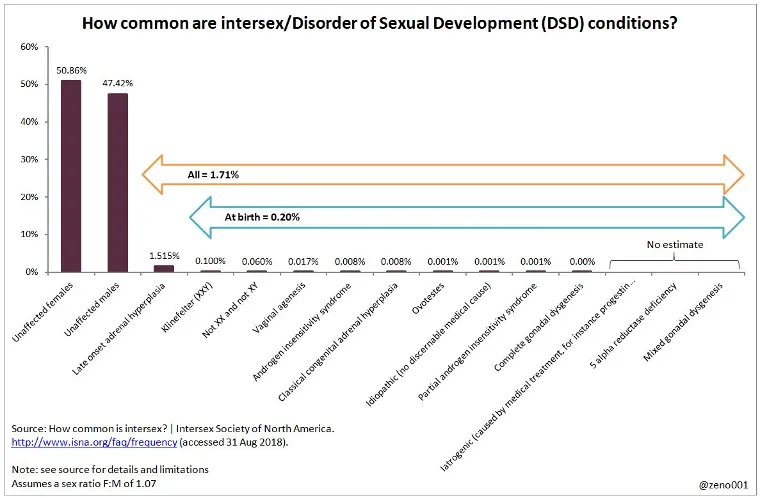You are using an out of date browser. It may not display this or other websites correctly.
You should upgrade or use an alternative browser.
You should upgrade or use an alternative browser.
Laughing @ lefty "logic"
- Thread starter Diogenes
- Start date

THIS THING IS LYING. LAUGH!
"About 1.7 percent of the population is intersex and don't fit neatly into male and female boxes."
Wrong, explains @SwipeWright: "The true prevalence of intersex is seen to be about 0.018%, almost 100 times lower".
“According to experts, around 1.7% of the population is born with intersex traits - comparable to the number of people born with red hair.” — Amnesty International
“Worldwide, up to 1.7% of people have intersex traits, roughly the same proportion of the population who have red hair.” — The Guardian
“An estimated 98-99 percent of humans are either blond or brunette. Despite this, we have accepted—rather than denying, hiding, or attempting to eliminate—the existence of redheads, who, interestingly, make up the same percentage of the population as intersex people (1-2 percent).” — Hida Viloria and Dr. Maria Nieto in The Spectrum of Sex: The Science of Male, Female, and Intersex (page 24)
Where does this 1.7 percent figure originate?
This statistic was first forwarded by Anne Fausto-Sterling, professor of biology and gender studies at Brown University, in her book “Sexing The Body: Gender Politics And The Construction Of Sexuality”, published in February of 2000, and shortly after in a review paper published a month later in the American Journal of Human Biology titled “How Sexually Dimorphic Are We?” In this review, Fausto-Sterling and her coauthors set out to refute the purported claim that sexual anatomy in humans is “absolutely dimorphic”, i.e. that all humans are either unambiguously male or female in all sex-related traits. They broadly define an intersex person as “an individual who deviates from the Platonic ideal of physical dimorphism at the chromosomal, genital, gonadal, or hormonal levels.”To arrive at their 1.7% figure, they asked how frequently humans deviate from this Platonic ideal. In the review, their “ideal male” is defined as someone with XY chromosomes, functional testes located in the scrotal sac, a penis between 2.5 and 4.5 cm at birth, and a completely enclosed urethra that opens at the tip. The ideal male must also have testes that produce Mullerian inhibiting factor as well as testosterone and dihydrotestosterone, and juvenile testicular activity must result in a typical masculinizing puberty. Their “ideal female” has two X chromosomes, functional ovaries that result in normal feminizing puberty, intact oviducts attached to a functional uterus, cervix, and vaginal canal. This ideal female must also have labia minora and majora present, and a clitoris that ranges between 0.20cm and 0.85cm in length at birth.
According to these strict criteria, approximately 1.7 percent of individuals can be defined as intersex, though the authors suggest this figure could even be as high as 2.27 percent if the criteria are made even more expansive.
Is this an accurate portrayal of intersex?
Defining an individual as intersex for deviating from their sex’s “Platonic ideal” for any trait stands out as extreme. In a 2002 paper titled “How Common is Intersex? A Response to Anne Fausto-Sterling,” physician and psychologist Leonard Sax pointed out a flaw in Fausto-Sterling’s 1.7 percent statistic; namely, that it included many conditions that cannot be considered intersex in any clinically relevant sense. Indeed, the conditions making up the large majority of Fausto-Sterling’s 1.7 percent figure do not result in any sexual ambiguity whatsoever. In Sax’s words:
Many reviewers are not aware that this [1.7 percent] figure includes conditions which most clinicians do not recognize as intersex, such as Klinefelter syndrome, Turner syndrome, and late-onset adrenal hyperplasia. If the term intersex is to retain any meaning, the term should be restricted to those conditions in which chromosomal sex is inconsistent with phenotypic sex, or in which the phenotype is not classifiable as either male or female. [emphasis added]
Fausto-Sterling’s central error was to equate any “differences of sexual development” (DSDs) with “intersex.” But while all intersex conditions may be considered DSDs, not all DSDs are necessarily intersex conditions.
The following figure using Fausto-Sterling’s data:

Here we can see that the large majority (88 percent) of Fausto-Sterling’s 1.7 percent figure is taken up by one condition: late-onset adrenal hyperplasia (LOCAH). These individuals have completely normal male or female genitalia at birth that align with their sex chromosomes. The sex of these individuals is not ambiguous, so to label LOCAH as an intersex condition is a far cry from what most people and clinicians conceptually envision the term to capture.
The next most prevalent DSD on Fausto-Sterling’s list include any chromosomal deviations from classical XX and XY (e.g. Klinefelter syndrome, Turner syndrome, etc.). However, these conditions do not result in ambiguous genitalia and therefore cannot be considered intersex in any clinically relevant sense.
Lastly, vaginal agenesis, the next most common DSD on the list, is not generally considered an intersex condition, as girls with this condition are genotypically XX, possess perfectly normal ovaries, and can become pregnant and birth their own children following vaginoplasty. They are unambiguously female.
When these common DSDs are removed, and intersex conditions are more precisely defined as “conditions in which chromosomal sex is inconsistent with phenotypic sex, or in which the phenotype is not classifiable as either male or female,” Fausto-Sterling’s 1.7 percent figure drops dramatically. According to Sax, “Applying this more precise definition, the true prevalence of intersex is seen to be about 0.018%, almost 100 times lower than Fausto-Sterling's estimate of 1.7%.”
While the prevalence of intersex conditions, defined in Sax’s clinically-relevant sense, is quite low, this by no means justifies any of the mistreatment, whether socially or medically, that many gender activists hope to prevent when they overstate its prevalence. How we treat people, and the rights afforded to them, should not be predicated on their prevalence within a population. And that is the point we should be trying to normalize, rather than false statistics.

Intersex Is Not as Common as Red Hair
The claim that intersex people comprise 1.7% of the population is wildly inaccurate.
If you ever had kids and were involved in raising them, you would have noticed friends and schoolmates who were different. Kids are born with differences including sexual ones. They have a tough time fitting in. They are as god made them. You should not make their lives worse.
If you ever had kids and were involved in raising them, you would have noticed friends and schoolmates who were different. Kids are born with differences including sexual ones. They have a tough time fitting in. They are as god made them. You should not make their lives worse.

This is *supposed* to be satire but it’s real life now. When art imitates life, I guess.
View: https://x.com/JebraFaushay/status/1894050716227969196
View: https://x.com/JebraFaushay/status/1894050716227969196
Yakuda
Verified User
Its amazing how you idiots think love means letting people do whatever the hell they please. It's not love to let someone with a penis believe they are a woman. And it's not love to encourage them to think they can be.If you ever had kids and were involved in raising them, you would have noticed friends and schoolmates who were different. Kids are born with differences including sexual ones. They have a tough time fitting in. They are as god made them. You should not make their lives worse.
Its amazing how you idiots think love means letting people do whatever the hell they please. It's not love to let someone with a penis believe they are a woman. And it's not love to encourage them to think they can be.
Leftfis don't think.




